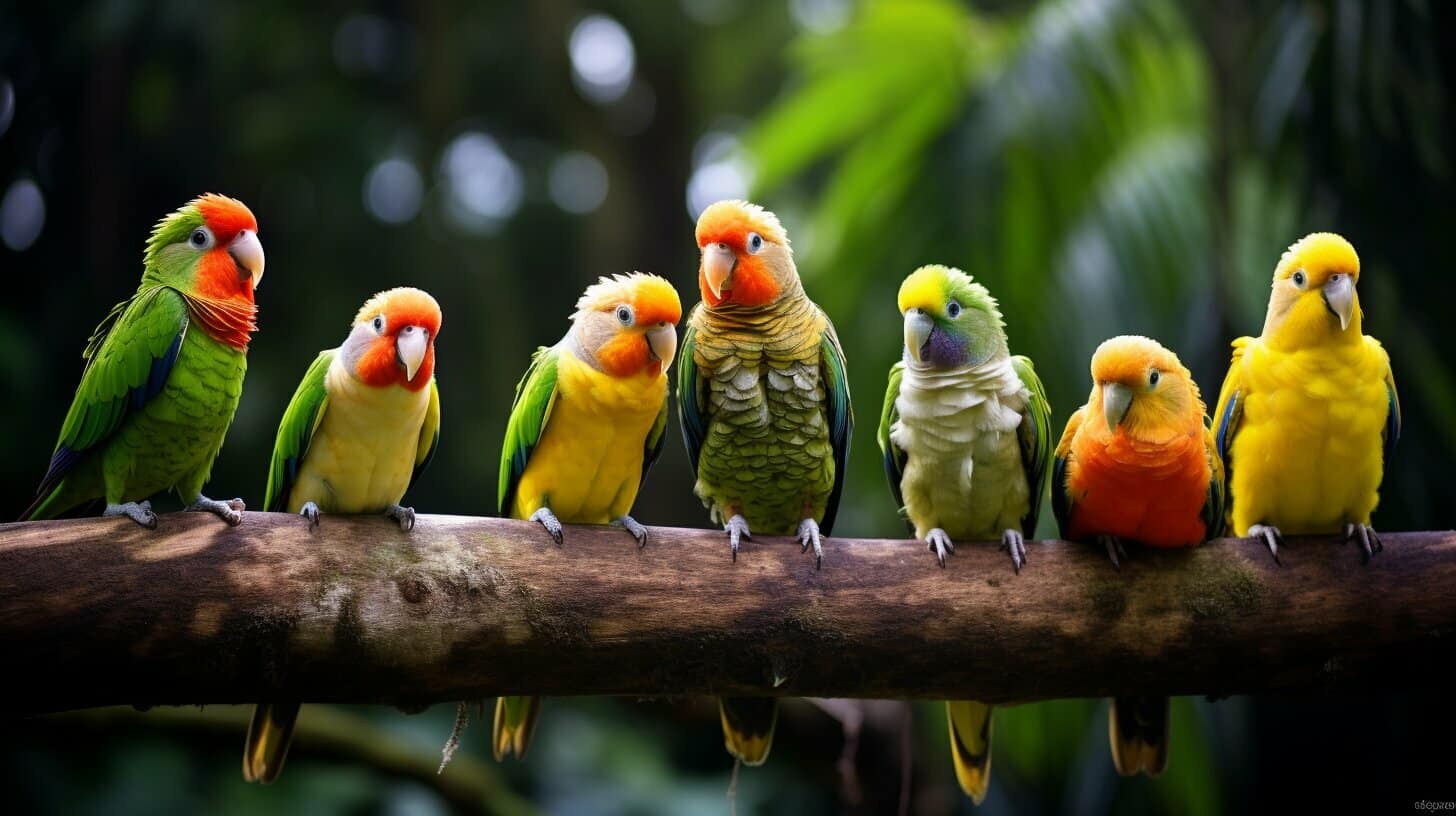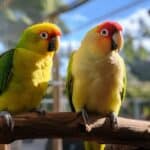Kakarikis are a lively and friendly species known for their playful and affectionate demeanour. For those who already have a bird or are considering getting one, whether kakarikis can coexist with other bird species is a valid concern.
While the answer is not straightforward and depends on several factors, including the temperament and size of the birds, there are ways to make it work. In this article, we will explore the social behaviour of kakarikis, and their compatibility with other birds and guide on creating a harmonious avian community.
Key Takeaways
- Kakarikis can live with other bird species under the right circumstances.
- Social behaviour and compatibility are important factors when housing multiple bird species together.
- Introducing birds slowly and providing adequate space and resources can lead to a successful communal living environment.
Understanding Kakariki Social Behavior
Kakarikis are social birds by nature and thrive in the company of their kind. They are known to be highly active and playful, often engaging in energetic activities such as flying, climbing, and playing with toys. When kept in pairs or groups, they display their natural behaviours more frequently, making it a worthwhile experience to witness.
However, their social behaviour with other bird species may vary depending on the individual birds’ temperament and the relationship established between them. Kakarikis may get along with some bird breeds while being aggressive or hostile towards others. Therefore, it’s essential to understand the potential social dynamics before introducing them to new birds.
Interaction with Other Birds
Kakarikis are generally friendly towards other birds of similar size and temperament. They enjoy playing and socializing with their avian counterparts, especially if they share similar activity levels. It’s not unusual to see kakarikis engaging in playful activities with other birds, such as chasing each other around the enclosure or sharing toys.
However, kakarikis can sometimes be territorial, especially if they perceive other birds as a threat. They may become aggressive, display dominant behaviours, or exhibit territorial markings. Therefore, when introducing new birds to a kakariki’s enclosure, monitoring their interactions closely is crucial to ensure that they get along well and avoid any potential conflicts.
Establishing a Hierarchy
When kakarikis are kept in pairs or groups, they tend to have a hierarchy system established, with one bird assuming a dominant role. This bird usually displays dominant behaviours, such as controlling access to food and toys or choosing the nesting location. The subordinate birds usually submit to the dominant bird and take a lower position in the hierarchy.
When introducing a new bird to a kakariki pair or group, it’s crucial to consider the existing hierarchy structure to avoid upsetting the balance. The new bird should be of a similar size and temperament to the other birds and ideally have a lower ranking in the hierarchy. Introducing a too dominant bird may lead to conflicts and aggression, while a submissive bird may be bullied or excluded from the group.
Understanding kakariki’s social behaviour is essential for creating a harmonious avian community. By choosing appropriate bird species, monitoring their interactions, and considering the hierarchy structure, you can create a safe and enjoyable living environment for your feathered friends.
Housing Kakarikis with Other Bird Species
When considering housing kakarikis with other bird species, there are several factors to keep in mind to ensure a safe and happy living environment for all birds involved.
Size of the Aviary
The size of the aviary is crucial in determining whether kakarikis can cohabitate with other bird species. The aviary must be spacious enough to provide ample room for each bird to fly, play, and rest comfortably. A crowded aviary can lead to stress, aggression, and territorial behaviour among birds, which may result in injury or death.
Behaviour and Temperament
It is important to consider the behaviour and temperament of other bird species when deciding on housing options. Some bird species are naturally more aggressive or territorial and may not be suitable companions for kakarikis. It is advisable to research the particular breed of bird and its behavioural characteristics before introducing them to a communal living environment.
Compatibility
Compatibility between kakarikis and other bird species is crucial to ensure a harmonious living situation. Some bird species have particular dietary requirements, which may differ from those of kakarikis. Additionally, some species may have specific environmental needs that could be at odds with those of kakarikis. It is essential to ensure that the bird species are compatible to avoid conflicts, stress, and injuries.
Observation and Monitoring
When introducing kakarikis to new bird species, it is essential to observe their behaviour, especially during the introductory phase. Watch for any aggressive behaviour, territorial disputes, or bullying. If any negative behaviour is observed, it is advisable to separate the birds immediately to avoid any injuries.
Following these considerations and best practices, kakarikis and other bird species can coexist safely and harmoniously in the same aviary.
Compatible Bird Species for Kakarikis
If you are considering introducing new birds to your kakariki’s aviary, ensuring that all birds have compatible characteristics is crucial. Below is a list of bird species that are known to coexist well with kakarikis:
| Bird Species | Compatibility Level |
|---|---|
| Budgerigars | High compatibility |
| Cockatiels | High compatibility |
| Canaries | High compatibility |
| Finches | High compatibility |
| Lovebirds | Moderate compatibility |
| Parrotlets | Moderate compatibility |
| Quaker Parrots | Moderate compatibility |
It is vital to note that the compatibility level of a particular bird species with kakarikis may vary from individual to individual. In some cases, a species with high compatibility with kakarikis may not get along with your specific bird. Therefore, monitoring the birds closely during the initial introduction period and observing their behaviour is advisable.
If you intend to introduce a new bird to your kakarikis, it is best to do so gradually. Place the new bird in a separate cage in the same room as your kakarikis to allow them to get used to each other’s presence. Once they seem comfortable being near each other without showing any signs of aggression, you can start slowly introducing them to each other under supervision.
Introducing Kakarikis to Other Birds
Introducing kakarikis to other birds can be tricky if not done correctly. It is important to remember that each bird has its unique personality, and some may not take kindly to new roommates. However, with patience and careful planning, it is possible to establish a peaceful community of birds in your aviary.
Before introducing kakarikis to other birds, it is essential to ensure they are healthy and disease-free. Quarantine any new birds for at least 30 days to ensure they are not carriers of any illnesses or parasites that could infect your existing birds. Ensure the quarantine area is separate from your other birds, with no shared equipment or personnel.
When it comes time to introduce your kakarikis to the other birds, start with short supervised visits. Place the bird in a separate cage within the aviary so they can see each other but cannot harm each other. Observe their behaviour to ensure there is no aggression or excessive intimidation.
Gradually increase the time the birds spend together, but never leave them unsupervised until you are sure they are compatible. If there are signs of aggression at any point, separate the birds and try again later. Remember, not all birds will get along, so don’t force it if it isn’t working.
It is also important to ensure enough space for each bird in the aviary. Overcrowding can lead to increased stress levels and territorial aggression. Provide plenty of perches, toys, and hiding places to reduce bird competition.
Lastly, be aware that the introduction process can take several weeks or months, so be patient and take your time. With persistence and careful observation, you can create a harmonious community of birds that includes your beloved kakarikis.
Creating a Bird Community with Kakarikis
Kakarikis are highly social birds that thrive in communal living situations. As a result, they can be great additions to a bird community when introduced correctly. In the wild, they form large flocks, and in captivity, they enjoy the company of other birds. However, it is important to choose compatible bird species to foster a harmonious environment.
When selecting birds to live with kakarikis, it is essential to consider the temperament and size of the other birds. While smaller birds may be intimidated by the energetic nature of kakarikis, but larger birds may threaten them. Therefore, it is best to choose birds similar in temperament and size to kakarikis.
Another factor to consider is the housing environment. If the birds are housed in the same aviary, it is essential to provide enough space for each bird to have its territory. Lack of space can lead to aggression and territorial disputes among the birds. Additionally, it is crucial to ensure that each bird has access to adequate food and water sources and that no aggressive or dominant birds may prevent others from accessing these resources.
Introducing kakarikis and other birds slowly and carefully is vital to avoid stress and aggression. A gradual introduction process can gradually help the birds adjust to each other’s presence. You can start by housing birds in separate cages next to each other for a few days, allowing them to become familiar with each other’s sounds and scents. Once they seem comfortable, you can allow them to interact under supervision, gradually increasing their time together.
Creating a bird community with kakarikis is a rewarding experience for both the birds and the owners. It provides the opportunity for socialization and enrichment, leading to healthier and happier birds. Still, it is crucial to consider compatibility and housing needs before introducing kakarikis to other bird species.
Aviary Mates for Kakarikis
While kakarikis can be housed with other bird species, it is important to carefully select suitable aviary mates to ensure a harmonious and safe living environment for all birds. Here are some bird species that are known to coexist well with kakarikis:
| Bird Species | Compatibility |
|---|---|
| Finches | Doves are peaceful, gentle birds that often coexist well with the more boisterous kakarikis. |
| Canaries | Canaries are gentle birds that are known to get along well with kakarikis. |
| Budgerigars | Budgerigars, also known as budgies, are often housed with kakarikis and can make good companions. However, it is important to monitor their interactions to ensure they get along well. |
| Lovebirds | Lovebirds are social birds and can be good companions for kakarikis. However, it is important to introduce them carefully to ensure they get along well. |
| Doves | Doves are peaceful and gentle birds that often coexist well with the more boisterous kakarikis. |
It is important to note that each bird is unique, and compatibility will depend on individual temperaments and personalities. Therefore, it is essential to monitor any new introductions carefully and be prepared to separate birds if necessary.
If you choose to house multiple bird species in the same aviary, ensure adequate space and resources (such as food and water) for all birds. Providing different perches and hiding places can also help to reduce competition and promote a peaceful living environment.
Conclusion
As we have seen, kakarikis can coexist with other bird species when introduced and housed correctly. Understanding their social behaviour is essential to providing a harmonious environment for all birds. When selecting aviary mates for your kakarikis, it is important to choose compatible species that have similar needs and temperaments.
Creating a bird community with kakarikis can be an enjoyable and fulfilling experience for bird enthusiasts. However, it is essential to research and consider the needs of each bird before introducing them to a communal living situation.
With proper consideration, it is possible to successfully house kakarikis with other birds and create a thriving avian community.
FAQ
Q: Can kakarikis live with other birds?
A: Kakarikis can live with other bird species if proper introductions and housing arrangements are made.
Q: What is the social behaviour of kakarikis with other birds?
A: Kakarikis are generally social birds and can interact well with other bird species if given enough space and stimulation.
Q: How should kakarikis be housed with other bird species?
A: Housing kakarikis with other bird species requires careful consideration of the size of the aviary or cage and providing enough perches and nesting spots for each species.
Q: Which bird species are compatible with kakarikis?
A: Some bird species that are known to coexist well with kakarikis include budgies, cockatiels, and finches.
Q: How can kakarikis be introduced to other birds?
A: To introduce kakarikis to other birds, it is recommended to do so gradually in neutral territory and closely monitor their interactions.
Q: What is the role of kakarikis in a bird community?
A: Kakarikis can play a valuable role in a bird community by adding diversity and contributing to the social dynamics of the group.
Q: Which bird species make suitable aviary mates for kakarikis?
A: Some popular choices for aviary mates for kakarikis include canaries, parakeets, and lovebirds.
Q: Can kakarikis live with other birds in harmony?
A: Yes, with proper introductions, housing, and monitoring, kakarikis can live harmoniously with other bird species.



Have comments or questions about this article? Then get involved!
Spotted an error or something we have missed? Let us know